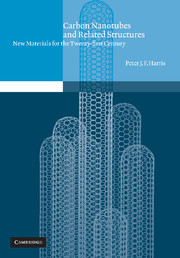Book contents
- Frontmatter
- Contents
- Acknowledgements
- 1 Introduction
- 2 Synthesis: Preparation methods, growth mechanisms and processing techniques
- 3 Structure
- 4 The physics of nanotubes
- 5 Nanocapsules and nanotest-tubes
- 6 The ultimate carbon fibre? The mechanical properties of carbon nanotubes
- 7 Curved crystals, inorganic fullerenes and nanorods
- 8 Carbon onions and spheroidal carbon
- 9 Future directions
- Name index
- Subject index
4 - The physics of nanotubes
Published online by Cambridge University Press: 28 January 2010
- Frontmatter
- Contents
- Acknowledgements
- 1 Introduction
- 2 Synthesis: Preparation methods, growth mechanisms and processing techniques
- 3 Structure
- 4 The physics of nanotubes
- 5 Nanocapsules and nanotest-tubes
- 6 The ultimate carbon fibre? The mechanical properties of carbon nanotubes
- 7 Curved crystals, inorganic fullerenes and nanorods
- 8 Carbon onions and spheroidal carbon
- 9 Future directions
- Name index
- Subject index
Summary
When we get to the very, very small world – say circuits of seven
atoms – we have a lot of new things that would happen that
represent completely new opportunities for design. Atoms on a
small scale behave like nothing on a large scale, for they satisfy the
laws of quantum mechanics.
Richard Feynman, There's plenty of room at the bottomWith diameters frequently less than 10 nm, carbon nanotubes fall into the size range where quantum effects become important, and this, combined with their unusual symmetries, has led theoreticians to predict some remarkable electronic, magnetic and lattice properties. As noted in Chapter 1, several groups around the world showed theoretically in late 1991 that nanotubes can be metals or semiconductors depending on their precise structure and diameter. This raised intriguing possibilities such as the idea of creating ‘insulated’ nanowires, in which a conducting tube would be isolated inside a semiconducting one. Other workers pointed out that nanotubes might exhibit exotic quantum mechanical behaviour such as the Aharonov–Bohm effect in the presence of a magnetic field. Initially, testing the theoretical predictions proved problematic. Measurements on the bulk material were difficult to interpret because bulk samples inevitably contained a wide variety of tube structures and sizes, as well as other material such as nanoparticles. The development of methods for purifying nanotube samples enabled some progress to be made, but the results were still rather difficult to interpret. Recently, however, a number of groups have succeeded in carrying out electronic measurements on individual nanotubes, and in constructing nanotube-based electronic devices. These remarkable experiments are among the highlights of nanotube research to date.
- Type
- Chapter
- Information
- Carbon Nanotubes and Related StructuresNew Materials for the Twenty-first Century, pp. 111 - 155Publisher: Cambridge University PressPrint publication year: 1999
- 2
- Cited by



